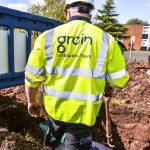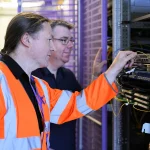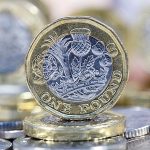NIC Wants UK Gov to Set Full Fibre Broadband Plan by Spring 2019 UPDATE2
The Government’s National Infrastructure Commission (NIC) has today published the United Kingdom’s first-ever National Infrastructure Assessment, which among other things calls for nationwide coverage of “full fibre” (FTTP/H) broadband by 2033 and for a related ‘National Broadband Plan‘ to be devised by Spring 2019.
The NIC, which is chaired by Sir John Armitt, consists of 7 commissioners including Dame Kate Barker, Professor Sir Tim Besley, Professor David Fisk, Andy Green, Professor Sadie Morgan, Julia Prescot and Bridget Rosewell. At present the NIC does not have statutory independence and their charter merely requires that the Gov respond to its recommendations “no more than a year after publication, and wherever possible within six months.”
At the time of writing we haven’t yet read the full report, although a sneak peek of the document seen by ISPreview.co.uk yesterday states that the broadband plan must deliver “full fibre connections across the whole of the country, including those in rural areas – this should ensure that the technology is available to 15 million homes and businesses by 2025, 25 million by 2030, and all homes and businesses by 2033.”
Advertisement
Building a digital society (Extract from the document)
The UK already has a strong digital economy underpinned by an extensive broadband network. But the superfast broadband programme that delivered this is coming to an end. While current digital connectivity is enough for current needs, demand for data is rapidly increasing; superfast broadband may not be sufficient for the future.
The Commission’s judgement is that the government should act now to deliver full fibre across the country; in the Commission’s social research, 86 per cent of people agreed that all parts of the UK should have equal access to broadband. Full fibre broadband is the likely next step in digital connectivity. It is more reliable and cheaper to maintain than today’s part copper, part fibre broadband connections. But it will take at least a decade to build nationally. Government needs to make a decision on full fibre now to avoid the risk of the UK being left behind in years to come. Full fibre will deliver benefits compared to current broadband even if the expected demand growth does not materialise. Enhanced digital connectivity will also facilitate the development of smart infrastructure: infrastructure with digital connections, enabling more efficient management and maintenance.
To encourage full fibre rollout, the government should put in place a national broadband plan by the end of 2018. Ofcom should provide certainty to commercial investors and encourage further private sector delivery of full fibre. With this certainty from government and Ofcom, most urban areas are likely to receive full fibre just through the promotion of market competition. However, full fibre will still need to be subsidised in some areas where commercial players are unlikely to deliver it. This should begin with the locations least likely to receive broadband commercially. With these plans in place, nationwide full fibre connectivity should be available no later than 2033.
Funnily enough the above sounds more or less identical to the Government’s new targets (here), which aim to achieve 10 million premises passed with “full fibre” (FTTH/P) by the end of 2022, rising to 15 million premises by 2025 and then there’s an aspiration to “deliver a nationwide full-fibre to the premises network” by 2033 (the latter will need masses of public funding and may not hold as government’s change).
The 2025 target will probably be achieved with existing commercial investment and support, while the 2033 aspiration is currently very vague and has no solid strategy or funding behind it. This is hardly surprising since the competitive commercial market is only just getting to grips with deploying FTTH/P at a large-scale.
Usually government’s like to give the private sector time to work these things out for themselves, before they go around offering big wads of public cash that might risk distorting commercial plans. Suffice to say we’d be surprised if a multi-billion commitment of public funding was made anytime soon, but you never know.
Sir John Armitt said:
“Whether it’s electric or driverless cars, new energy sources, tackling the risk of climate change or preparing for the newest and fastest broadband speeds, the issues we’ve been considering profoundly affect people’s everyday lives.
The whole purpose of the UK’s first-ever National Infrastructure Assessment is to think beyond the technologies of today and to ensure we can make the most of future innovations. It’s why it’s not just a one-off but something we will be repeating every five years to ensure we remain on the front foot.
This is not some unaffordable wish-list of projects: it sets a clear direction for how to meet the country’s future infrastructure needs, and makes a realistic assessment of what can and should be delivered within the stated aim of Ministers for steady and continued investment over the coming years.
I therefore look forward to the Government’s response to our report, and seeing how our recommendations can become reality.”
In fairness the Government has already begun acting to boost FTTP/H connectivity, not least via new regulation from Ofcom’s Strategic Review (details) and a 5 year business rates holiday on new fibre optic lines, as well as improvements to the Electronic Communications Code (here) and several large funding schemes to support 5G or “full fibre” development (here).
Advertisement
The result has been to encourage a lot of alternative network (AltNet) ISPs to significantly grow their plans, while the incumbents are doing the same. For example, Hyperoptic now aims to cover 2 million premises with FTTH/P by 2022 (aspiration for 5 million by 2025), while Vodafone with Cityfibre will reach 1 million by 2021 (aspiration for up to 5 million by 2025), Virgin Media hope to build 2 million, Openreach will do 3 million by 2020 and hopefully 10 million by 2025 etc. (see our ‘Summary of Full Fibre Broadband Plans and Investment‘ for more).
But as we’ve said before, anything happening around 2033 is likely to involve a different government and political ambitions or economic realities can easily change. In other words, the only real way to build and ensure a solid strategy that could last up until 2033 is to establish one with cross-party support (easier said than done given the current ideological divisions between parties).
An Openreach Spokesperson said:
“We share the Government’s full fibre vision for Britain. This year we’ll double our FTTP footprint and by 2020, we will have built it to 3 million homes across the UK.
We want to reach 10m premises by the mid-2020s, and believe we can ultimately fully-fibre the majority of the UK under the right conditions.
This is an expensive, complex, once-in-a-generation engineering project which the industry can only deliver with longer term certainty over the return on investment.
We therefore agree with the NIC’s view that to achieve the 2033 ambition, the UK needs to cut the cost of full fibre deployment, promote a competitive market with a stable regulatory regime, and commit to deregulate in areas where competition is effective.”
All of this naturally comes just before the Government are due to set out their stall on this subject via the Future Telecoms Infrastructure Review, which will form the foundation for everything discussed above. Speaking of political instability, this discussion could soon be a moot point if the current Brexit crisis results in yet another snap General Election during the autumn.
UPDATE 10:33am
Advertisement
Added a comment from Openreach above.
UPDATE 3:35pm
Added a comment from Gigaclear below and the full report is now available here.
Mike Surrey, CEO of Gigaclear, said:
“We welcome the National Infrastructure Commission’s assessment. We fully support its call for a National Broadband Plan to deliver full fibre connections across England, including rural areas, by Spring 2019. At Gigaclear, our mission is to address the rural digital divide by delivering only future proofed full fibre, and we have seen first-hand how transformative this connectivity is for those who live and work in rural areas.
Through the Government’s BDUK programme, Gigaclear will have installed new full fibre connections to approximately 150,000 rural premises by the end of 2020; this is in addition to the 150,000 premises connected under our commercial build programme. Without further Government support, the remaining rural areas are likely to be left behind. Full fibre infrastructure offers enormous potential to the UK’s digital economy, and we look forward to working with the NIC, Government bodies and other parties involved to help drive the transformation to deliver gigabit connectivity to rural England.”
Mark is a professional technology writer, IT consultant and computer engineer from Dorset (England), he also founded ISPreview in 1999 and enjoys analysing the latest telecoms and broadband developments. Find me on X (Twitter), Mastodon, Facebook, BlueSky, Threads.net and Linkedin.
« BT TV App Update Adds Content Download Feature and Multi-Device

















































Comments are closed